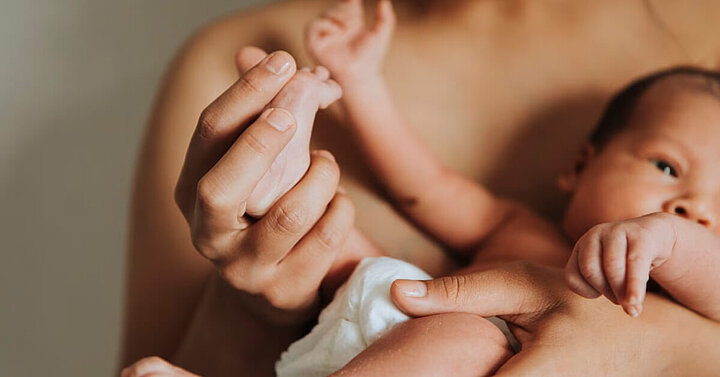What to expect after a vaginal birth
Postpartum | Wellbeing | | Aby Tobin
Many aspects of becoming a Mum can come as a surprise and most have said the phrase “why did no one tell me?”. So, here are some things that can occur as a result of a vaginal birth and what you can do to help your recovery.
1. Vaginal heaviness, dragging sensation or bulging.
These symptoms are very common and would even be considered normal in the early weeks after birth. Your baby stretched the vaginal walls and pelvic floor on their exit and so this can lead to prolapse type symptoms. This does not mean you have a prolapse. A prolapse is when a pelvic organ such as the bladder is pushing down into the stretched vaginal wall long term. The key difference is that after birth this is an acute injury that the body is working to heal.
2. Bruised and swollen vulva
All vaginal births will cause some degree of trauma to the vulval tissues. Your labia can feel puffy, tender and be vibrant bruised shades. The vulva has an excellent blood supply and lots of nerve endings, so it can be very sore. This should settle down significantly in the first 1 – 2 weeks post birth.
3. The mother of all periods
Postpartum blood loss is called lochia, and it happens after all births – C Section or vaginal. The reason for the sheer volume of it is because your uterus has to revert back to its unpregnant state. After 40 weeks of building the perfect nest in there, it takes time to clear out.
There are three stages to the process. The first stage will last around four days; it will be dark red blood and even small clots are normal. Your uterus continues contracting to help the process and so expect intense, period-like cramps. These cramps can be more intense when breastfeeding, and with each subsequent child you deliver. From day 4 to 10 it will change from fresh to a pinkish brown discharge and the clots should be stopping. Then finally a yellow/white discharge, occasionally some light bleeding but no clots. The full clear-out is usually complete by 6 weeks.
It's important to know what isn’t considered normal too, so if any of these are happening get in touch with your GP urgently.
- Your bleeding slows/stops and then starts again.
- Soaking through a pad in less than an hour.
- Passing clots bigger than a golf ball.
- Have a fever or flu like symptoms.
- High levels of persistent abdominal pain.
4. Birth injuries
9 in 10 first time Mums will experience a tear or episiotomy, it’s very hard to avoid but the majority heal well and do not cause future issues. Many women are aware that something happened down there but in the blur of the post birth fixing up they aren’t sure exactly what.
On your hospital discharge form it will detail any birth injuries and it’s important for you to know what you are healing from. The most common injury is a tear to your perineum, which is the area between your vaginal opening and your anus. You can also get tears elsewhere and again this should be communicated to you. For a perineal tear you will be told a grade, which is how severe the tear was. Here’s what they mean:
- Grade 1: superficial graze of the skin, may or may not require a couple of stitches.
- Grade 2: a tear of the skin and muscles underneath.
- Grade 3: a tear all the way back through to the anal sphincters, this grade is further broken down into a, b, and c and details the extent of injury to the sphincter muscles.
- Grade 4: a tear all the way from the vaginal opening through the anal sphincters and involving the bowel lining.
- Episiotomy: a cut made by a medical professional to widen the vaginal opening making more space for the baby to come through. Usually, this is done to prevent severe perineal tearing, or to protect the life of you or your baby. It should have been communicated to you why it was necessary in your case.
What can you do to help?
Naturally, these types of injuries come with some pain and discomfort. With the right treatment, you should heal quickly.
- Take as much time off your feet as you can in the first few weeks and avoid lifting anything heavy to give the pelvic floor a break.
- Keep on top of pain relief – you’ll be up in the night and so keep it going around the clock. If you are unsure what you can take then speak with your midwife, GP or pharmacist.
- Wear knickers with breathable material such as cotton to prevent infection and change sanitary towels regularly.
- Give any wounds air time by taking underwear off and sitting on a towel or incontinence pad to protect your bed or sofa from the postpartum bleeding.
- Warm, shallow baths (sometimes called sitz baths) with lavender oil can reduce inflammation and infection. Keep it to 5 mins so any stitches don’t dissolve prematurely. Make sure to gently pat dry with a clean towel. Alternatively, sitz baths
- You can get postpartum sprays to soothe swelling and aid healing, my favourite is Spritz for Bits by My Expert Midwife.
- To take the edge off stingy wees keep hydrated so your wee is nice and pale, it’s the yellow urea that makes it sting. Also, fill a clean bottle with warm water and pour it down your labia as you wee to further dilute the wee as it hits any sore bits. Dry gently with toilet paper or baby wipes.
- Don’t avoid bowel movements – you’ll regret it. Keep hydrated and use a stool softener if needed to prevent constipation. You can help protect your perineum by pressing on it with a clean sanitary towel while you poo. Make sanitary towels into handy ice packs by storing them in the freezer.
- Pelvic floor activations (also called Kegels or pelvic floor exercises) will bring blood flow to the area and help healing. Keep within comfort levels of 3/10 pain or less and work on getting a full lift and release of the muscles.
- If you still have any concerning symptoms persisting by your 8 week GP check then flag them as this needs checking by a pelvic health physio to prevent long term issues.


